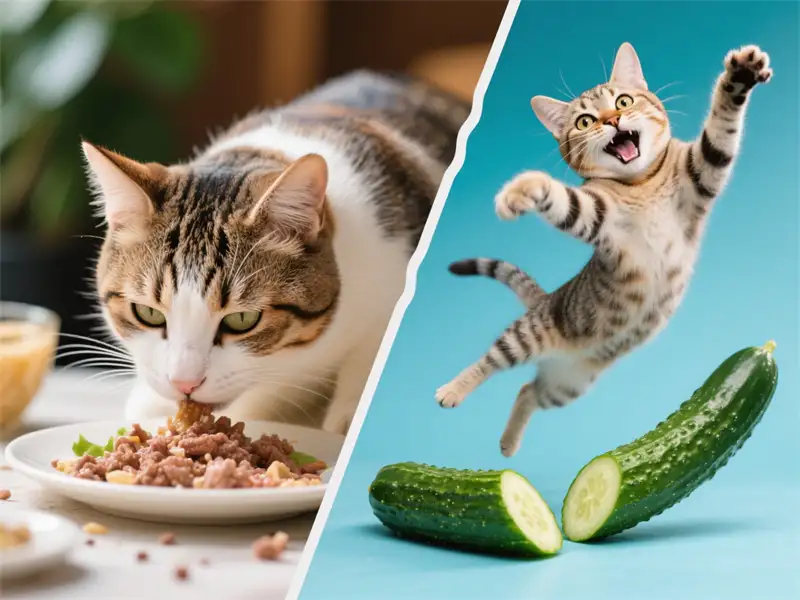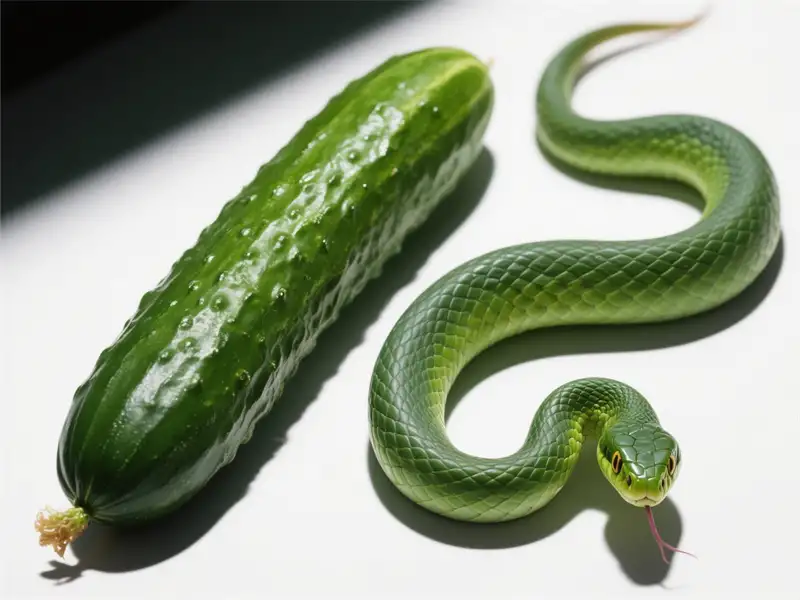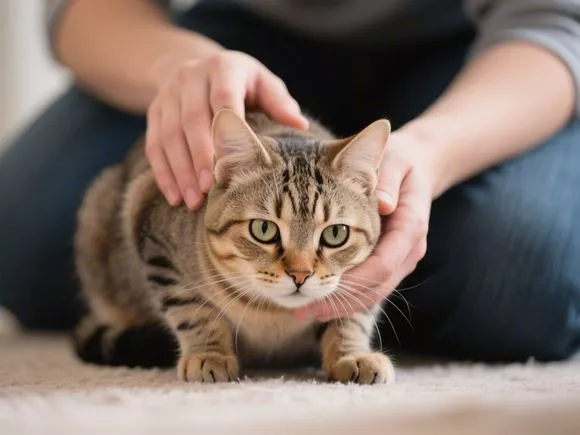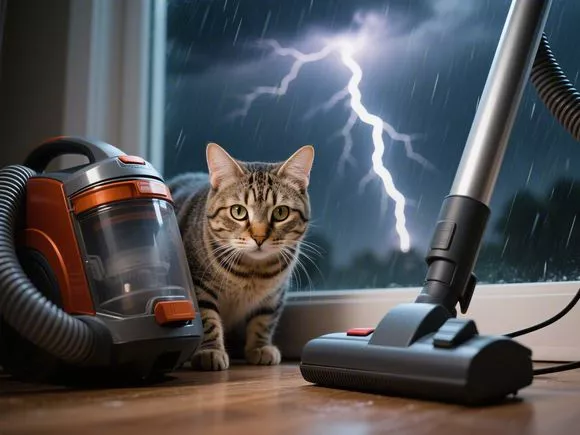You’ve probably scrolled past them: the countless viral videos capturing a baffling feline behavior. A cat is minding its own business, perhaps munching on kibble or grooming, when its owner stealthily places a cucumber nearby. The cat turns, spots the green intruder, and launches into the air, often scrambling away in sheer terror. It’s a reaction so dramatic it’s become an internet sensation. But why are cats afraid of cucumbers? What is it about this common, harmless vegetable that sends our furry companions into such a panic?
Is it something inherent in the cucumber itself, or is there a deeper, more instinctual explanation at play? We’ll dive into the science behind this strange phenomenon, explore the leading behavioral theories, and most importantly, discuss why experts strongly advise against recreating these startling scenarios for a cheap laugh.

Spoiler alert: It’s likely less about the cucumber specifically and more about the shock of the unexpected.
(The Primary Culprit: The Startle Response)
It’s All About Surprise!
The most widely accepted explanation among animal behaviorists has less to do with the cucumber itself and everything to do with how it suddenly appears. Cats, like many animals (including humans!), are hardwired with strong survival instincts. A crucial part of this is the startle response – an automatic, defensive reaction to sudden, unexpected stimuli in their environment.
Think about it: cats are hyper-aware of their surroundings, especially in areas they consider safe, like their feeding station or favorite napping spot. When an object – any object, not just a cucumber – appears seemingly out of nowhere right behind them, it triggers this powerful reflex. Their dramatic leap is an instinctive attempt to quickly get away from a potential, unknown threat.
Imagine you’re deeply focused on a task, and someone silently places a strange object right beside you. When you finally notice it, you’d likely jump too! For cats, whose instincts are finely tuned to detect predators, this unexpected appearance is highly alarming. The cucumber isn’t inherently scary; the surprise is.
(The Snake Mimicry Theory)
Could It Look Like a Snake?
Another popular theory that frequently circulates online is the snake mimicry theory. This idea suggests that the long, green shape of a cucumber might subconsciously trigger a cat’s innate fear of snakes.
Snakes are natural predators for small mammals in the wild, and it’s plausible that an instinctual aversion to snake-like shapes could be embedded in a cat’s genetic programming as a survival mechanism. The sudden appearance of something resembling a potential predator could certainly provoke a strong fear response.
While this theory is intriguing and might play a role for some cats, many experts believe the startle response offers a more comprehensive explanation. Why? Because cats can exhibit similar startled reactions to other objects (like bananas or zucchinis) placed sneakily behind them, even if those objects don’t resemble snakes as closely. The consistency of the reaction across different objects points more strongly towards the element of surprise being the primary driver.

(Why You SHOULD NOT Scare Your Cat with Cucumbers)
More Harm Than Humor: The Negative Impacts
While the videos might seem funny on the surface, intentionally scaring your cat with a cucumber (or anything else) is strongly discouraged by veterinarians and animal behaviorists. Here’s why setting up these “pranks” is a bad idea:
- Causes Severe Stress and Anxiety: Startling your cat induces fear and stress. Chronic stress can lead to behavioral problems (like hiding, aggression, or litter box issues) and even physical health problems over time.
- Risk of Physical Injury: A panicked cat might leap erratically, crashing into furniture, walls, or other objects. This could easily result in injury to themselves or damage to your home.
- Erodes Trust and Safety: Cats thrive on predictability and feeling secure in their environment. Scaring them, especially near their food bowls or resting places, can create negative associations with these essential areas. They might become wary, anxious, and lose trust in the person who scared them.
- It’s Simply Unkind: Responsible pet ownership involves providing a safe, nurturing, and loving environment. Intentionally causing fear and distress for your own amusement goes against the very core of that responsibility. Our pets rely on us for safety, not cheap thrills at their expense.

(Understanding Cat Fears Beyond Cucumbers)
What Else Startles Our Feline Friends?
The cucumber phenomenon highlights a cat’s sensitivity to the unexpected. Understanding this can help us be more mindful of other potential triggers in their environment. Common things that can startle or frighten cats include:
- Loud, sudden noises: Vacuums, blenders, fireworks, dropped objects, doors slamming.
- Fast, unpredictable movements: People rushing past, objects falling, even overly energetic play.
- Other unexpectedly placed objects: Not just cucumbers, but anything unfamiliar appearing suddenly.
- Sudden approach of strangers or unfamiliar animals.
Recognizing these sensitivities allows us to create a more predictable and calming home environment, minimizing unnecessary stress for our feline companions.

(Conclusion)
Respect the Reflex, Ditch the Prank
So, the viral mystery of why cats are afraid of cucumbers isn’t really about the vegetable itself. It primarily boils down to the element of surprise, triggering a cat’s powerful, instinctual startle response. While the snake mimicry theory might contribute a layer of subconscious fear for some felines due to the cucumber’s shape, the sudden, unexpected appearance in a perceived safe zone is the most consistent explanation.
Most importantly, understanding why it happens also clarifies why we shouldn’t make it happen. Intentionally startling your cat, whether with a cucumber or anything else, causes unnecessary stress, risks injury, and can damage the precious bond of trust you share.
Instead of seeking laughs at your cat’s expense, let’s focus on positive interactions, engaging playtime (with appropriate toys!), and creating a secure, loving environment where they feel safe, cherished, and understood. After all, a calm and trusting cat is a happy cat.
Have you observed other surprising cat behaviors or fears? Share your experiences (respectfully!) in the comments below!
(Optional FAQ Section)
Frequently Asked Questions
- Q: Are all cats afraid of cucumbers?
- A: No, not all cats react the same way. A cat’s individual temperament, past experiences, and how the object is presented all play a role. Some cats might just be curious or indifferent.
- Q: Is it okay if my cat sees a cucumber normally, like on the kitchen counter?
- A: Absolutely! The issue isn’t the cucumber itself. It becomes a problem only when it’s used intentionally to sneak up on and startle the cat.
- Q: My cat seems generally anxious or easily startled. What should I do?
- A: If your cat shows signs of excessive anxiety or fear, it’s best to consult with your veterinarian. They can rule out underlying medical issues and may refer you to a certified cat behaviorist for specialized help.